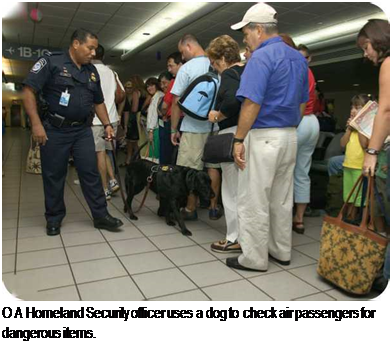Passenger Procedures
Passengers entering an airport must check in with their airline. On many
international flights, check-in time may be two or more hours before takeoff because of growing security measures at the world’s airports.
At the check-in desk, passengers’ baggage is weighed and labeled. Each passenger is allocated a seat in the plane and given a boarding pass. Baggage is checked by machines and security personnel before being loaded into the baggage hold of the airplane. Security became a serious issue in the 1970s after a number of attempts by terrorists to hijack airliners. Even tougher security came into force at airports after the terrorist attacks of September 11, 2001. All airlines now impose strict regulations on what air travelers are allowed to carry, especially in small hand baggage taken into the cabin.
 At the airport, passengers pass ^ through security gates before boarding their plane. Security checks involve body scanning and X-rays of all hand baggage. |jw Passengers may be asked to remove shoes, belts, and metal objects before they pass through the electronic scanning gates. Security officers make sure no weapons or explosives get on board the plane.
At the airport, passengers pass ^ through security gates before boarding their plane. Security checks involve body scanning and X-rays of all hand baggage. |jw Passengers may be asked to remove shoes, belts, and metal objects before they pass through the electronic scanning gates. Security officers make sure no weapons or explosives get on board the plane.
Passengers move through into
a departure zone to wait for their [___ .
flight. In large airports, they may ride from the main terminal to a smaller satellite terminal on a shuttle bus, monorail, or electric vehicle. While they wait, passengers can usually eat or shop in the airport facilities. They can check their departure information on monitors (each airline flight has a number to identify it).










